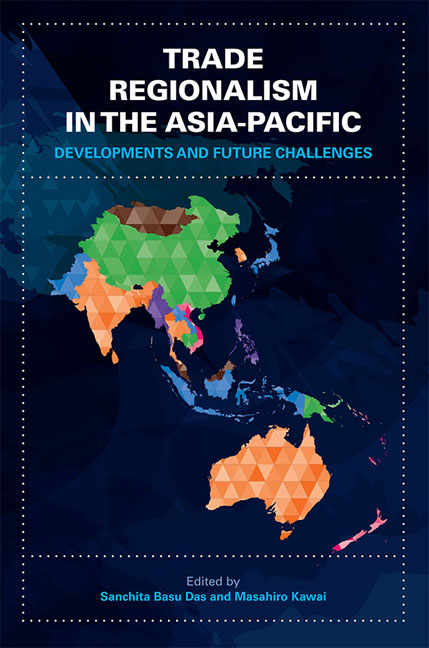Book contents
- Frontmatter
- Contents
- Foreword
- Acknowledgments
- List of Abbreviations
- The Contributors
- 1 Introductory Overview — Trade Regionalism in the Asia-Pacific: Developments and Future Challenges
- I The Trans-Pacific Partnership (TPP) Agreement
- II The Regional Comprehensive Economic Partnership (RCEP) Agreement
- III Regional Economic Integration: A Multi-stage Approach
- 10 AEC and ASEAN+1 FTAs: Progress, Challenges and Future
- 11 CJK FTA Rationale, Prospects and Challenges
- IV Old and Emerging Approaches to Asia-Pacific Regional Integration
- V Asia-Pacific Regional Integration: Towards Convergence?
- Index
10 - AEC and ASEAN+1 FTAs: Progress, Challenges and Future
from III - Regional Economic Integration: A Multi-stage Approach
Published online by Cambridge University Press: 05 July 2016
- Frontmatter
- Contents
- Foreword
- Acknowledgments
- List of Abbreviations
- The Contributors
- 1 Introductory Overview — Trade Regionalism in the Asia-Pacific: Developments and Future Challenges
- I The Trans-Pacific Partnership (TPP) Agreement
- II The Regional Comprehensive Economic Partnership (RCEP) Agreement
- III Regional Economic Integration: A Multi-stage Approach
- 10 AEC and ASEAN+1 FTAs: Progress, Challenges and Future
- 11 CJK FTA Rationale, Prospects and Challenges
- IV Old and Emerging Approaches to Asia-Pacific Regional Integration
- V Asia-Pacific Regional Integration: Towards Convergence?
- Index
Summary
INTRODUCTION
The Asia-Pacific region is seeing growing economic integration through market-driven production networks, and through plurilateral and bilateral Free Trade Agreements (FTAs) and the emerging mega-trade blocs of the Regional Comprehensive Economic Partnership (RCEP) and Trans-Pacific Partnership (TPP). Both economic and political factors are driving the proliferation of FTAs in East Asia. The former is the push for economic growth and employment through improved economic competitiveness, access to markets and investments, and the strengthening of regional production networks and supply chains. The latter is to promote regional resilience and traditional and non-traditional security through closer cooperation.
Bilateral FTAs are proliferating among East Asian and non-East Asian countries. Plurilateral FTAs have also mushroomed, such as the ASEAN+1 FTAs. This proliferation is driven by the following developments: the stalled World Trade Organization (WTO) Doha Round and need for alternative paths to trade and investment liberalization; the shock of the Asian Financial Crisis (AFC) in the late 1990s impelling countries in the region to work more closely together; the desire to partially imitate North American and European regional economic integration; the fear of being left out of preferential deals and its resulting domino effect; and the desire to have a stronger East Asian voice and presence in the international fora. Questions that arise from such proliferation include: Will they be effective in liberalizing trade and investment flows? Will they undermine the WTO and the multilateral trading system? Will the various stakeholders, particularly the business community, find them useful and helpful? Will they create a “noodle bowl” phenomenon that actually fragments markets and add to business costs?
ASEAN has been playing a central role in FTA formation in the region. The ASEAN Free Trade Area (AFTA) entered into force in 1993, ASEAN Framework Agreement of Services (AFAS) in 1995, and ASEAN Investment Area (AIA) in 1997 and was succeeded by the ASEAN Economic Community (AEC) in 2007, ASEAN Trade in Goods Agreement (ATIGA) in 2010, and ASEAN Comprehensive Investment Agreement (ACIA) in 2012. The development of FTA networks with ASEAN';s Dialogue Partners has been an integral part of the AEC.
- Type
- Chapter
- Information
- Trade Regionalism in the Asia-PacificDevelopments and Future Challenges, pp. 185 - 212Publisher: ISEAS–Yusof Ishak InstitutePrint publication year: 2016



